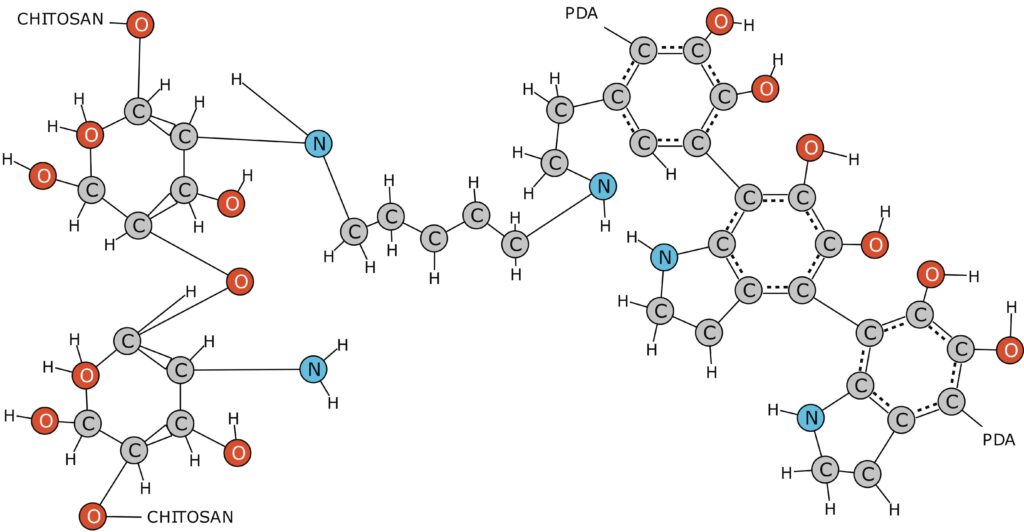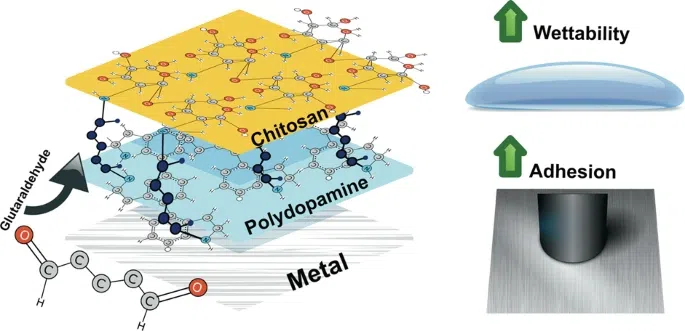Recent work from a research collaboration has led to exciting new developments in polymer-metal interfacial adhesion. The team investigated methods to strengthen adhesion of chitosan, a biocompatible and biodegradable polymer, to metal surfaces. Such polymer-metal interfaces have promising applications in biomedical devices, including implants and biosensors.
New Linking Approach Leads to Record Adhesion Strengths
The researchers covalently linked chitosan to a polydopamine (PDA) interlayer on stainless steel using glutaraldehyde as a linking agent. This “linked-PDA” approach led to average adhesion strengths of 5.48 MPa—over double that of a standard silane-linked approach (2.84 MPa) and over 5 times greater than a bare PDA interlayer (1.46 MPa). The linked-PDA adhesion strength was comparable to that of a bare metal surface (5.66 MPa), showing the effectiveness of the linking method.
Depth profiling and spectroscopic analysis revealed that the chitosan-PDA linking primarily occurred near the outer surface of the coating. The glutaraldehyde linking led to the formation of lactam bonds between amine groups of chitosan and PDA. While underlying PDA layers were less modified, the high concentration of linking at the surface was sufficient to enable record adhesion strengths. These findings indicate that adhesion strength depends primarily on the outer surface modification and bonds, not the bulk properties of the interlayer.
Facile, Versatile Approach with Broad Applicability
The ease of PDA and glutaraldehyde deposition, as well as the wide range of materials the approach can coat, adds to its promise. PDA can coat many metal and inorganic substrates, enabling a broad range of applications. The ease of glutaraldehyde deposition, spectroscopic characterization, and depth profiling also facilitates study of the linking method. The biocompatibilities of chitosan, PDA, and glutaraldehyde, and the tunability of chitosan properties, suggest the method could improve biological interfaces. Overall, this linking approach and in-depth analysis can advance understanding and optimization of interfaces for demanding biomedical applications.
Future work could investigate the effects of coating and linking parameters, such as thickness and concentration, on adhesion. The adhesion and degradation of coatings in biologically relevant media could also be examined. Finally, the method could be applied to other polymers, interlayers, and substrates to gauge its wider potential. There is significant promise for the linked-PDA approach to advance coatings for biomedical metal interfaces.

Linking Approach Facilitates Study of Interface Formation
To investigate adhesion and linking mechanisms, the researchers developed methods for controlled, reproducible sample preparation and in-depth characterization. Stainless steel substrates were cleaned and modified with a PDA interlayer. Glutaraldehyde treatment and chitosan deposition were performed through immersion and rinsing steps with calibrated solutions and times. Characterization including pull-off testing, contact angle measurements, XPS, and ToF-SIMS depth profiling allowed for quantification and analysis of adhesion strengths, surface properties, and chemistry at the interface. These methods enabled systematic study of how changes in the coating approach affect adhesion and a view into the origins of the high adhesion achieved. Controlled synthesis and multi-modal characterization could help enable optimization of interfaces and further study of PDA and glutaraldehyde linking effects.

- For cleaning, the stainless steel substrates were ultrasonicated in acetone and isopropyl alcohol, then rinsed with deionized water. This prepares the surface by removing contaminants. The PDA interlayer was deposited by immersing the substrates in a 10 mg/mL dopamine solution for 2 hours. Rinsing with water removed excess dopamine.
- For glutaraldehyde treatment, substrates were immersed in a 2.5 wt% solution for 30 minutes. This crosslinks amine groups of PDA, forming imine bonds. Rinsing removed excess glutaraldehyde. 0.5 wt% chitosan was then deposited via 30-minute immersion.
- Pull-off testing used an epoxy glue to adhere metal studs to the chitosan coating. A testing machine pulled the studs perpendicular to the surface and measured the force required to separate the coating. Higher forces indicate stronger adhesion.
- Contact angle measurements used sessile water and 1-bromonaphthalene (1BN) droplets. 1BN measures dispersive interactions as it is nonpolar, while water also measures polar interactions. Measurements determine the components of surface tension, related to the hydrophilicity or hydrophobicity.
- XPS spectra were collected at different depths by using an argon ion gun to etch away material in thin layers. This revealed the chemistry at the outer surface (EL1), after some etching (EL2), and at the metal interface (EL4-EL7). Changes in surface composition with depth confirmed where the PDA-chitosan linking occurred. Binding energy measurements identified the specific chemical groups present.
Novel Linking Approach Achieves Record Adhesion Strengths
The linked-PDA approach led to average adhesion strengths of 5.48 MPa, over double those of a silane-linked interlayer (2.84 MPa) and over 5 times greater than a bare PDA interlayer (1.46 MPa). The linked-PDA adhesion was comparable to that of a bare metal surface (5.66 MPa), showing the effectiveness of linking PDA and chitosan with glutaraldehyde. Depth profiling and XPS analysis revealed that the linking is concentrated near the outer surface of the coating. While the underlying PDA layers were less modified, the high concentration of linking at the surface is sufficient to achieve strong adhesion. The results indicate that adhesion depends primarily on surface modification and bonds, not bulk interlayer properties. The linked-PDA approach and analysis of mechanisms could help advance understanding and optimization of polymer-metal interfaces for applications requiring strong and durable adhesion.

- The pull-off testing results showed that the linked-PDA approach achieved the highest adhesion strength of the methods tested. The adhesion strength was comparable to that of a bare metal surface, showing the effectiveness of the linking in achieving strong bonding between the chitosan and stainless steel. The high adhesion could be useful for applications where strong and durable interfaces are needed.
- Contact angle measurements revealed that the linked-PDA coating was more hydrophilic than the silane-linked coating. The PDA interlayer and chitosan coating were more hydrophilic than the silane, and the glutaraldehyde linking did not significantly change this. Thus, the higher adhesion of the linked-PDA coating was attributed to the chemical linking, not changes in surface wettability.
- XPS depth profiling and spectra showed that the concentrations of aldehyde groups and lactam bonds were highest at the outer surface (EL1) after glutaraldehyde treatment. These groups provide evidence for the PDA-chitosan linking. While the underlying PDA layers (EL2-EL3) had lower concentrations of linking, the higher amounts at the surface were sufficient to lead to strong adhesion. The results demonstrate that adhesion depends on the surface bonds and modification, not the bulk properties of the interlayer.
- Additional details could be included on the specific binding energies that were used to identify each chemical group and the atomic compositions at different depths. The trends in compositions with depth corroborated the localization of linking effects near the outer surface.
Promising Biomedical Applications for a Versatile, High-Performance Approach
The strong, durable adhesion achieved through linking PDA and chitosan could be valuable for biomedical interfaces that undergo mechanical stresses. The biocompatibilities of the coating materials suggest promise for implants and biosensors. Chitosan‘s biodegradability could enable temporary interfaces that degrade once no longer needed. The ease of the linking approach and range of materials it can coat adds versatility to explore diverse applications. With further study of degradation, toxicity, and parameters, the linked-PDA method could enable advances in implants, biosensors, drug delivery, and other biomedical devices requiring polymer-metal interfaces with robust and controlled adhesion and properties.
- The high adhesion strength suggests the linked-PDA coatings could maintain strong bonding even under the stresses involved in implants and biosensors. The adhesion was comparable to a bare metal surface, indicating potential for durable adhesion comparable to or stronger than traditional interfaces. This could be important for implants that undergo significant motion or forces in the body.
- The biocompatibilities of chitosan, PDA, and glutaraldehyde in the specific concentrations used would need to be confirmed for biological applications. However, these materials are often biocompatible, and the concentrations could potentially be tuned to balance adhesion and biological safety. The biodegradability of chitosan could be useful for temporary interfaces, enabling degradation once an application such as drug delivery is complete.
- The versatility of materials the PDA and glutaraldehyde linking approach can coat could enable diverse applications. In addition to stainless steel, titanium, cobalt-chromium alloys, and other metals could potentially be coated. Different polymers could create interfaces with unique properties. By varying the unctional groups of PDA or chitosan, properties such as degradation rate could be tuned. The facile nature of the method could facilitate studying and optimizing interfaces for diverse applications.
- Additional work could examine the effects of parameters such as coating thickness or glutaraldehyde concentration on adhesion, as well as degradation of the coatings in biological fluids. This could help enable the method to achieve controlled adhesion strengths and degradation for specific applications. While promising, further study of biological safety and performance is needed to assess potential for implants and other medical applications. The linking approach and in-depth analysis could also reveal new insights to advance biomedical interfaces.
Novelty of the strong adhesion achieved and versatility/broader relevance of the linking approach
The study’s key novelties lie in the strong adhesion achieved through linking PDA and chitosan with glutaraldehyde and the approach’s versatility and broader insights. The average adhesion strength of 5.48 MPa for the linked-PDA coating represents a significant increase over previous PDA-chitosan interfaces. The ease of deposition and range of materials that can be coated adds versatility. Depth profiling and spectroscopic analysis provide insights into factors influencing adhesion. While applied to polymer-metal interfaces here, the linking approach and analysis could advance understanding of adhesion mechanisms for broader material combinations and applications. These key innovations help enable achievement and optimization of strong, durable adhesion for demanding applications.

- The adhesion strength of 5.48 MPa for the linked-PDA coating represents a substantial increase over standard PDA-chitosan interfaces. The strength was comparable to that of a bare metal surface, showing the potential to achieve adhesion as strong as possible for a polymer-metal interface. This significant increase in adhesion could help enable applications where strong bonding is necessary.
- The versatility of the PDA and glutaraldehyde linking approach allows for diverse materials to be tested. In addition to stainless steel, other metals, polymers, and interlayers could be explored. By varying the materials, key factors influencing adhesion could be studied, and interfaces with unique properties could be created for different applications. The facile nature of the approach facilitates exploring diverse possibilities.
- The depth profiling and spectroscopic analysis provide insights into the origins of the strong adhesion. The concentration of linking at the outer surface and the types of bonds formed were revealed in detail. While the focus here was a PDA-chitosan interface, the analytical approaches could give valuable insights into adhesion mechanisms for other material combinations. Understanding the precise factors governing adhesion could help researchers better design and optimize interfaces for diverse applications.
- Although the study focused on a polymer-metal interface, the PDA and glutaraldehyde linking approach and analysis methods could be extended to other materials. The key factors influencing adhesion may differ for polymer-polymer, metal-ceramic, and other interfaces, and the versatility of the linking approach allows for their study. The analytical methods also provide a platform to examine adhesion for a wide range of materials. Gaining a fuller understanding of adhesion across material combinations could enable innovations in broader technologies.
By crafting an ingenious yet elemental joining of layers and relentlessly delving into the mysteries of their union, the team wrought interfaces with mighty adhesion—and revealed the profound wonders and rules that govern such power.
According to a recent study of Deniz Eren Erişen et all, a novel linked polydopamine-chitosan coating achieved record adhesion strength for stainless steel surfaces
To read the full article, click on the link, then on the “PDF” button on the right side of the page to open the full-text PDF.
